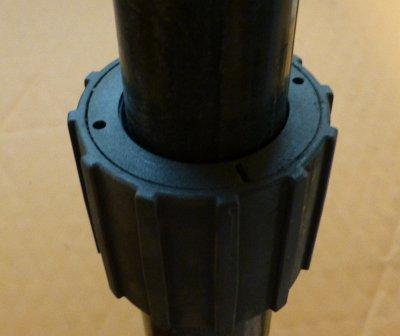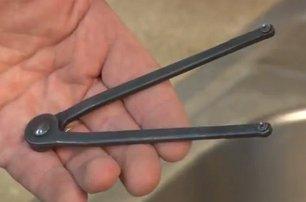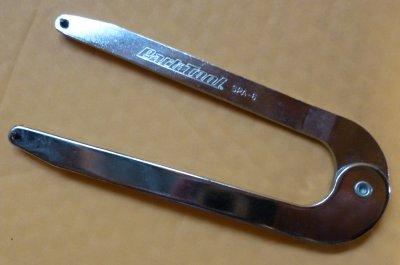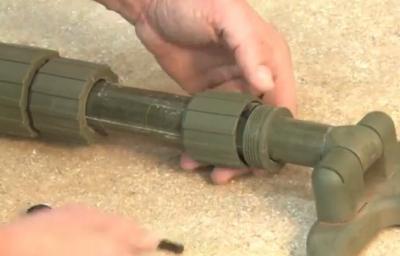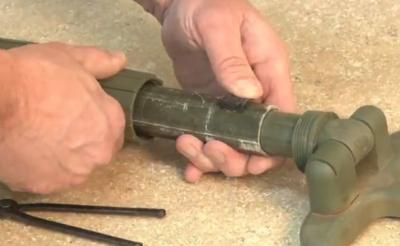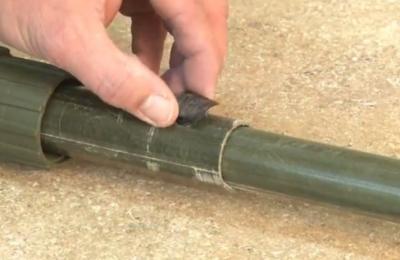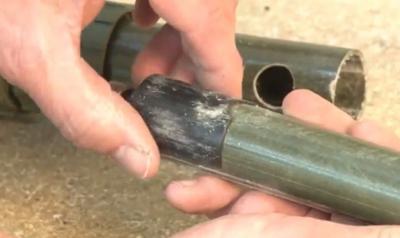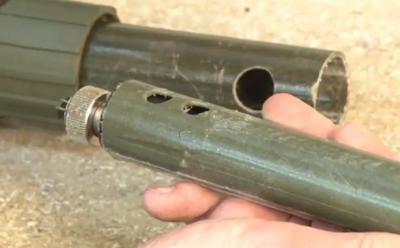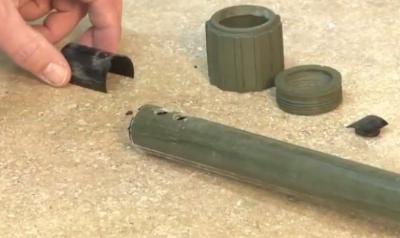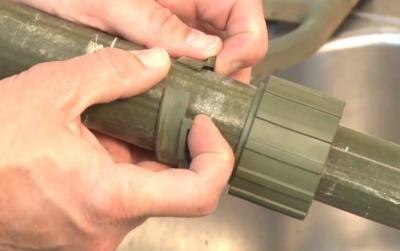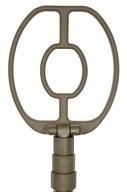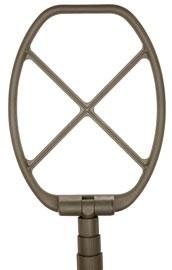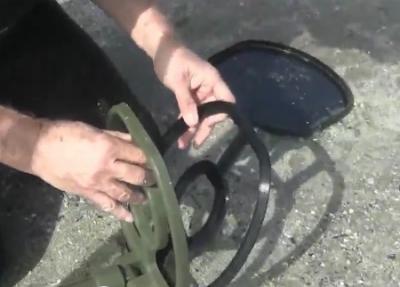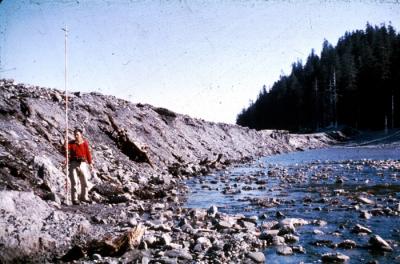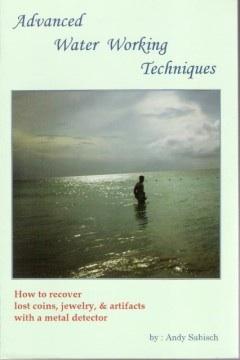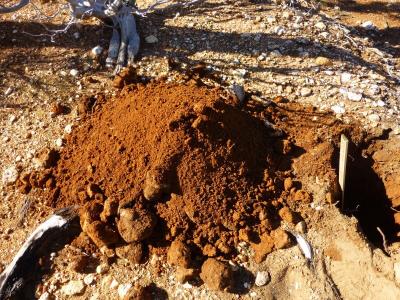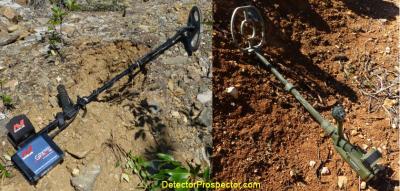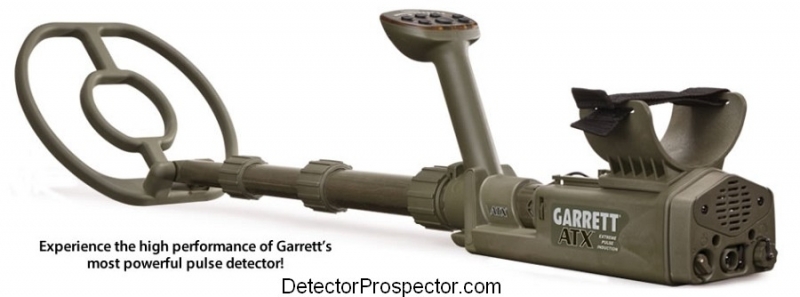-
Posts
19,773 -
Joined
Content Type
Forums
Detector Prospector Home
Detector Database
Downloads
Everything posted by Steve Herschbach
-
Well, that was interesting. I just played around with my ATX and a couple hot rocks, one a mild negative rock and the other a strong positive when ATX ground balanced to my ground. I put the ATX in FAST (LED 13) tracking and worked the strong positive rock. It seemed like nothing was happening but over the course a several minutes I could tell the rock was getting tracked out. I removed the rock, and the balance point had indeed changed as now the ground balance was off for the ground itself. I went at it again, and using the milder negative rock again it took minutes to see the tracking occur. I also tried the SLOW (LED 5) setting and it was so slow I just got bored and quit. The bottom line is that in my opinion the tracking is so incredibly slow I am not sure it serves any purpose. Garrett has said that the fast tracking on the ATX is about the same as the slow tracking on the Infinium. So they dialed the ATX back, but it sure looks to me that they went too far. It tracks so slowly it would not really help at all in variable ground. It looks to me like it is pretty safe to use though in that it might help keep the ground balance tuned just right as you go with incremental tracking but with about zero risk of tracking out a real target. I would be interested in hearing if anyone has an ATX that seems to track more effectively. As I noted I generally never use tracking anyway but if I did use it I would want it to be more aggressive than what I am seeing on the ATX. I can see why some people think it is doing nothing because it is so slow.
-
From Interview with Dave Johnson at http://www.fisherlab.com/hobby/davejohnson/Interview%20with%20David%20Johnson.pdf Many of the people reading this interview unknowingly own products of your design. Would you mind listing them? My first metal detector (in 1971) was a portable experimental vehicle detector for use on roadway loops. It discriminated between cars and trucks, but to become a practical product would have required a lot of development and nobody was interested in investing in it. Fisher in California: 1260, 1220, 1210, 1235, 1225, 1212, 1265, 1266, CZ6, CZ5, CZ20, original Gold Bug, Gold Bug II, Gemini, and industrial instruments including TW6, FX3, XLT-16, PF-18, and circuitry of the TW-770. Tesoro: Diablo MicroMax, Lobo SuperTraq. White's: GMT, MXT, analog circuitry of DFX, Beach Hunter and PCL-600 line tracer. Troy: X-5 and X-3. FTP Bounty Hunter: major revisions to existing platforms most of which originated with George Payne. The BH Junior, Platinum, Gold and security wand (sold under various trademarks) were new designs. FTP Teknetics: T2, Alpha, Delta, Gamma, Omega, G2. FTP Fisher: F2, F4, F5, F75, F70, new Gold Bug, circuitry of the TW-82 industrial line tracer. In the case of microprocessor-driven FTP products, the software was coded by John Gardiner and Jorge Anton Saad. Mechanical designs were done mostly by other people, but I engineered the ergonomics of the T2 mechanical design, which is also used on the F75. See also Detector Stuff Interviews FT-Fisher Engineers, David Johnson and John Gardiner at http://detectorstuff.com/detector-stuff-interviews-ft-fisher-engineers-david-johnson-and-john-gardiner/ Want people to know you own one of the Dave Johnson detectors listed above? Just download and print the attached logo and apply to your detector.
-
Ok, I am going to get to the bottom of this one. A couple people have noted on the internet that the ground tracking did not really seem to be doing much. I usually do not use tracking but the one time I turned it on it also seemed like not much was happening. I will give it go tomorrow and find out for sure what is going on and report back. I can tell you what the intent would be. In extremely variable ground ground tracking could be preferable to constantly having to manually ground balance the detector every few feet. A PI is very forgiving so we are talking really variable ground. I really have not run into something like that myself except in cobble piles made up of all sorts of different rocks. Tracking smooths everything out but also takes the edge off nugget responses. The faster the tracking, the more the nugget responses attenuate and possibly even are lost in extreme cases being treated as ground noise. The newer generation Minelabs also let you choose tracking speeds but nearly everyone runs in fixed (no tracking) for the reasons noted above. I am pretty doubtful many people would ever need to use tracking on the ATX but you have me curious now. From manual page 17 at http://www.garrett.com/hobbysite/hbby-manuals/1534000_atx_manual_rev_a.pdf Ground Track When switched on, Ground Track provides slow, continuous tracking to ground mineralization. The ATX has four Ground Track settings: OFF, SLOW, MEDIUM, and FAST, with OFF being the factory default setting. To change the Ground Track setting: • Press and release the SHIFT button to access Secondary controls. • Repeatedly press the GND TRACK button to step through the four settings (see illustration below). OFF is indicated by LED 1, SLOW is indicated by LED 5, MEDIUM by LED 9, and FAST by LED 13. • Press and release SHIFT button again to exit Secondary adjustments. • The green LED will blink during operation when Ground Track is on. Note: Ground Track may reduce detection depth due to slowly tracking to a target, especially with repeated swings over the target. Therefore, Ground Track should only be used when changing ground mineralization requires frequent re-ground balancing.
-

Jonathan Porter Video Interview
Steve Herschbach replied to Steve Herschbach's topic in Detector Prospector Forum
After consulting with the boss I was basically told I am an idiot if I do not jump at an opportunity to go back to Australia. Think Minelab would be interested in another video? -
You have to love a story like this. A guy goes into a shop and never having owned a metal detector before buys a new Garrett Ace 150, Garrett's lowest price entry model. He goes out for the first time, digs a couple items, and then finds a gold coin. Not just one gold coin though - he proceeds to dig up 55 of them! Eventually 159 coins worth over $150,000 are recovered. How is that for beginners luck? And what does he do to top that? http://www.dailymail.co.uk/news/article-2336423/I-Roman-coins-worth-100-000--20-minutes-buying-metal-detector-Novice-unearths-nationally-significant-treasure-hunt.html
-

Disassemble & Clean Garrett ATX Shaft & Cams
Steve Herschbach replied to Steve Herschbach's topic in Garrett Metal Detectors
Nice thing about the ATX is it comes with two sets of batteries. One set alkaline AA, and one set NiMH AA rechargeables. Both use the same four cell battery holder (two holders for each eight battery set). So the ATX basically comes with spare battery holders already. -
I have sold a lot of gold specimens and I have concluded the price you get is governed mostly by exposure and time. Exposure, as in how many people can you make aware of it. And time, because getting a good price can take lots of time. The more people you can market to and the more time you have, the higher the price you can get. A third factor is general affordability. You can get a far higher price per ounce for small specimens than large simply because more people can afford the money and so you have more potential buyers. Getting a good price for big gold is hard because the number of potential buyers is so small. I got my best prices by going high and putting the nugget on a web page where it can sit a year or two. Things like eBay auctions happen too fast to get good exposure and so limit the potential price. Better to just list and wait. The price to a large degree you just wing by looking at websites and prices of similar stuff - "the competition". But in the end you can ask whatever you want but the higher the price, the longer you have yo be willing to wait. The more you can say about the specimen, where it was found and how, the story if you will, can make a big difference. That one looks like an easy $500 or $600 to me but just winging it. Beautiful specimen! Let's see what others think.
-
I know if only four confirmed meteorite discoveries in Alaska, and one of those is suspicious. I have no doubt many meteorites exist in Alaska, but most would be very deep beneath muck and muskeg. Worth looking for though because a genuine Alaska discovery would be worth a lot of money just because of the cachet attached to anything Alaska these days. Aggie Creek, Alaska Meteorite http://www.minsocam.org/ammin/AM34/AM34_229.pdf Hope Creek, Alaska Meteorite (possibly from Texas) (http://www.meteoritemarket.com/HCR.htm) Chilkoot and Cold Bay Meteorites http://www.lpi.usra.edu/meteor/metbull.php?sea=Alaska&sfor=places&stype=exact&lrec=50&country=United+States&srt= More on Chilkoot Meteorite see page 457 http://evols.library.manoa.hawaii.edu/bitstream/handle/10524/35669/vol2-Cent-China(LO).pdf Meteorite Crater Near Bettles, Alaska http://www2.gi.alaska.edu/ScienceForum/ASF1/172.html Avak Impact Crater, Alaska http://impactcraters.us/avak_alaska Overall Location Map http://lunarmeteoritehunters.blogspot.com/2013/07/alaska-meteorites.html
-
Well, Garrett put out a video so the cat is out of the bag about the ATX. It is possible to disassemble and clean the coil lower rod and locking cam assembly. There was some debate about this because if you do it you could make things worse. Also, spare parts are not available at this time so if you lose or break something you are up the creek without the proverbial paddle. Be sure you watch the video carefully and never, ever force anything. Please note that all of this applies to water hunters. I can't imagine this being needed in normal above water use. There are instructions starting at 21:30 (near the end) in the new video below: Here are outtakes and basic instructions. First, if you look at the three cam locks closely you will see small indentations on each ring: Each set of indentations is set at a different distance apart so you need an adjustable pin spanner. Garrett is selling one for $35.95: I did not know about Garrett spanner at the time so I went to the REI bike parts area and purchased a Park Tool SPA-6 spanner for $17.95. The pins on it are about 2.2mm and are quite snug in the indents so the holes appear to be about 2.2mm. Also, the clearance is very close between the pins and shaft so I had to grind a bit off each inside edge of the tool to get the pins into the holes. The Garrett will no doubt work perfectly but this one is half the price and you may be able to get it locally. http://www.parktool.com/product/adjustable-spanner-spa-6 Insert the tool into the holes in the ring and apply pressure carefully. If you can't get it apart easily I do not know what to tell you but do not break it! If you mess things up it will probably not be warranty. Pull the cam halves apart and there will be a black tab underneath set in a hole in the shaft: With the tab removed you can now pull the rod assembly apart. Under where the tab was on the inner rod surface there will be a black plastic tensioning shim/plate set into two holes in the shaft. OK, you have taken it apart and have all the parts in front of you: Wash everything carefully with water. I had one cam that would not free up no matter what I did and disassembly revealed sand that I could not get out no matter what without disassembly. I used a tooth brush and got rid of every bit of grit. It appears to me excessive working of the mechanism while full of sand causes more wear than taking it apart and cleaning, but disassembly has its own risks. Basically, I would only do this is normal washing does not do the trick. Again, you are on your own if you break or lose something. Now, reassemble in reverse order. DO NOT use any lubricants or grease that will just attract and hold more sand in the future. The uppermost cam has a ring that must be loosened and moved up the shaft to give the cam enough room to come apart. Pull it carefully apart but do not go so far as to break it. Pry apart until it comes out of retaining holes and slide up the shaft. My advice to Garrett was to make this public but there were serious concerns about people doing more damage than good. The lack of spare parts at this time is especially disconcerting but hopefully will be addressed because these parts are going to wear and going to need replacement. Again, please note that all of this applies to water hunters. Other users need not be concerned. Anyway, I did it myself after I got back from Hawaii. Two cams on my 8" mono rod flushed out just fine but the uppermost one just refused to get fully clean. I blasted it with a Water Pik, I tapped on it while dry, but some grit stayed inside and kept it from moving freely. It still worked, but I could tell it was not right. Disassembly and cleaning did the trick and I am sure it will for others with similar issues. But be careful!!
-

Coil Scuff Covers For Garrett ATX
Steve Herschbach replied to Steve Herschbach's topic in Garrett Metal Detectors
It appears new units are shipping out with them. Early ones did not; mine had none. I have no idea what Garrett's policy will be for early owners - seems like they should get a free coil cover for being early on the bandwagon. Still no part numbers on Garrett website or anywhere else I have looked so they are out there but not readily available. -
From page 27 of the Garrett ATX Owners Manual: "Coil covers: Use a coil cover to protect the coil from abrasion and damage and prevent false responses that may occur when the coil abruptly impacts a rigid object such as a large rock, etc." I agree, especially when coils have an MSRP over $500, that you want to protect them. Nugget detecting in particular subjects coils to a lot of abrasion and hard knocks. Standard Garrett ATX Searchcoil 10" x 12" (25 x 31cm) DD Coil Part Number 2234600.....$529.95 Optional Garrett ATX Searchcoil 8" (20cm) Mono Coil Part Number 2234000.....$529.95 Excellent depth on small targets. Enhanced maneuverability in heavy scrub and tight areas. Optional Garrett ATX Searchcoil Deepseeker® 15" x 20" (38 x 50cm) Mono Coil Part Number 2234100.....$599.95 Use for locating larger and more deeply buried objects. Includes surface debris elimination. Garrett has been playing catch up, as even existing coils like the round 8" mono do not have a scuff cover available yet. Still, Garrett is on it, and at least two coils are now being made for the stock DD coil, a closed and an open scuff cover. Here is a picture of them but I have not been able to find part numbers yet. Hopefully Ken or one of the other dealers can chime in with part numbers and pricing. Scuff covers for Garrett ATX 10" x 12" DD Coil For those of you without a scuff cover do not be overly concerned. I have been using my ATX full bore without scuff covers and the end result is that the bottoms of the coils are scuffed and lightly abraded. My 8" mono in particular got a hard go of it in Hawaii. The epoxy bottom is tough and it will take a lot of use to have an appreciable effect so I would not worry too much about it from a service aspect. The main concern is when you go to sell the detector, a scuff cover means the coils look closer to new than well used. They are a good investment for that reason alone in maintaining the resale value of the detector.
-
That is how I hunt gold with the Gold Bug 2! A different noise in the midst of the noise. I promise you similar methods will work with the ATX. The problem and promise with modern metal detectors still is signal processing. If your ear can discern those signals with a Gold Bug 2 then in theory proper software can do the same, eliminating the noise and allowing the signal to be heard. For now though we have to use our ears and brains. The good news is the expertise to do so is rare and I dare say you have got it!
-
There is a lot of resistance to getting detectors set to run quiet because it involves reducing settings that reduce sensitivities. On the beach it is common to encounter what you have described. A tone at one end of a swing. Usually it is when walking parallel to the beach and on the downswing to the water. The sand is getting wetter in that direction, and the increase in salinity produces a signal. The real problem is on the upswing. The autotune/automatic threshold circuitry is trying to keep a steady tone going. On the downswing it is working to suppress the tone. When you swing the other direction the circuits lag catching up and the machine will go dead quiet. The detector now in effect has a threshold that has been set way too low, and any faint targets encountered on the upswing will probably be missed. The downswing is not an issue as much as you are basically supercharging the threshold but a faint signal can also get missed in the midst of the overall signal. It has been hard for me but more and more I am setting my detectors to find the hottest setting that gives quiet, even performance, even if that in theory dumbs the machine down. Tuning too hot in theory lights up a target that might otherwise be missed but then again it may still get missed because it sounds like noise. In the end it is up to the engineer to deliver a detector to me with enough power that when properly tuned it gets the results, and the ATX does just that. The Sensitivity works by reducing overall target response while the Discrimination (pulse delay) acts first on tiny low conductive targets. Reducing Sensitivity will reduce the response on both a gold chain and a large ring. Increasing the pulse delay can cause the same gold chain to give a reduced response but have less impact on the response from the ring. So increasing the Discrimination a notch may be more beneficial with rings than dropping the sensitivity a couple notches. Notice in the owner manual excerpt below reducing sensitivity is the last suggested option. Finally, the ATX does now have a ground balance circuit that can run into the salt range. This means you can use the ground balance to eliminate salt effects while leaving the Sensitivity and Discrimination at the most sensitive settings. This is being billed as having the capability of eliminating the salt effect while retaining sensitivity to more gold items. I honestly am still sorting out which combination of settings works best on which targets but in the end it is something you do want to experiment with yourself. Anything you discover would be a great help if you post about it. You can be sure I will do the same. The pulse delay is measured in microseconds and on a Whites TDI the control runs from about 10 uS to 25 uS. I do not know what the range is on the ATX but it is similar. Short delay times light up tiny gold but also light up saltwater because both respond the same. To be good on small gold nuggets the ATX has to have a short delay range, but to work in salt water you must be able to adjust the range higher. From PI guru Eric Foster at Link deleted since Findmall update broke all old links "A delay of 10uS is the best for sensitivity to small gold jewellery, but dropping back to 15 is not going to dramatically affect the sensitivity except for things like ear ring studs, very thin chains, broken rings etc. Two things that do affect the shortest pulse delay that can be used are the salinity of the water, and the nature of any wave action. These two factors are interdependant, as wave action in more saline water will give the greater effect. Certain places on the coast have the sea water diluted due to river outflow, and here the effects are much less. The nature of the beach can also have an effect. i.e. the ratio of solid material to water; underlying clay or bedrock, and any iron mineralisation present. Some detectors do not have an adjustable delay and this would limit their flexibility.". Long story short reducing the Sensitivity or increasing the Discrimination (pulse delay) and the Ground Balance or a combination of any of them to eliminate that downswing signal is a good idea. Or, work straight down to the water and then straight back up along with slower swings can keep the effect under control to a large degree. Garrett ATX Owner Manual page 28 Saltwater Operation When mixed with water, salt and other electrolytes become conductive and may therefore cause any detector to respond as if the saltwater were a metal target. In fact, to a detector, saltwater has an electrical conductivity very similar to foil, fine gold and other poor conductors. Traditionally with pulse detectors, to address the saltwater response the Delay/Discrimination setting was increased until the saltwater response was sufficiently eliminated. This method, although effective, can significantly reduce the detection of fine gold, jewelry, and other poor conductors due to the increased Discrimination setting. Therefore, to help reduce this undesirable loss of detection, the ATX has an alternative method to address saltwater. Specifically, the ATX can automatically ground balance out the saltwater response without the need to increase Discrimination; thereby maintaining a better response to fine gold, jewelry, and other poor conductors. The two methods to address saltwater are: 1) Ground Balance Method: Leave Discrimination set to minimum and Ground Balance to the saltwater as would be done for any other ground. This method will provide the best detection of fine gold, etc., but will produce a low-tone response for all targets. It is important to Ground Balance the detector when it moves to a new region of the beach (i.e. from wet sand to dry sand at the water's edge). 2) Traditional Discrimination Method: Incrementally increase the Discrimination setting until the saltwater response is sufficiently eliminated, typically around 3–7. Ground Balance is not required with this method. This method will maintain normal high and low tone responses, but will have reduced detection of fine gold, etc. Reduce the Discrimination setting toward zero when moving from wet sand to dry. For either method, the following basic techniques will help to achieve the best performance: 1. Swing the searchcoil flat and at a constant height. Do not bounce the coil or lift the coil at the end of swings. 2. Hunt the three different regions of the beach (dry sand, wet sand, submerged) one at a time rather than going back and forth between regions.This will allow the detector to be set optimally for each region. 3.Swing the searchcoil parallel to the water's edge to minimize changes in moisture levels within a given swing. The detector may become less stable in shallow, breaking surf where the searchcoil is in and out of the saltwater. In this area the detector is encountering a constantly changing environment produced by the surf, making it more difficult for the detector to stabilize. Experiment with the two methods above to determine which you prefer, and if necessary, reduce Sensitivity to obtain stable operation. Excellent post by Eric Foster on same subject Link deleted since Findmall update broke all old links
- 22 replies
-
- jewelry detecting
- garrett atx
-
(and 1 more)
Tagged with:
-
The Good Friday Earthquake was my first geology lesson. It taught me that in geology some things do not happen slowly but all at once. Streams can flow gently for decades or hundreds of years, and then change dramatically in days of massive flooding. The earthquake caused massive changes to terrain overnight. One end of Montegue Island was raised over 30 feet. Latouche Island moved almost 60 feet to the southeast. The end result was that the Pacific plate moved under the North American Plate about 30 feet on average. http://www.geo.arizona.edu/~nhartnes/alaska/uplift.html Mountains often do not grow slowly but in fits and starts. Alaska Earthquake March 27, 1964. Hanning Bay fault scarp on Montague Island, looking northwest. Vertical displacement in the foreground, in rock, is about 12 feet. The maximum measured displacement of 14 feet is at the beach ridge near the trees in the background. Figure 8, U.S. Geological Survey Professional paper 541. http://libraryphoto.cr.usgs.gov/cgi-bin/search.cgi?search_mode=exact;selection=Alaska%20Earthquake%201964%7CAlaska%20Earthquake%7C1964;start=0
-
Fifty years ago I was six years old sitting on the couch at home watching TV in my home town of Anchorage, Alaska. We lived in a new subdivision called Turnagain-By-The-Sea. It was Good Friday and I was watching an afternoon children's show, Fireball XL-5. The old black and white TV shut off, the picture shrinking down to that little white dot. Our dog was running like crazy through the house and and the house began to slowly move like a ship at sea. Earthquake! My parents gathered my siblings and I in the living room which by then was moving up and down so much we could not walk, and so we just huddled together in the middle of the room and held on to each other. The house was riding ground swells up and down and it seemed to go on forever. Everything loose in the house was falling over and everything in cabinets was crashing to the floor. I have been in very many earthquakes now in my life but this was totally different. Most quakes are a quick jolt or a shake. This was a very slow movement up and then down, exactly like being in sea swells. The ground raised us up, and then dropped away below us. It was very frightening to have solid earth turn into nothing of the sort. Instead of seconds the quake lasted for several very long minutes. Finally the movement subsided and we were all fine. A forest that used to be between the Turnagain subdivision and the inlet was gone, replaced by a sunken crazy quilt of broken land and trees. Houses once visible out our back window had gone over the edge. My father was in the National Guard and was called out to help while the rest of us were evacuated to high ground for fear of tsunamis. That thankfully never appeared in Anchorage but which devastated other communities in Alaska. http://time.com/3746785/the-great-alaska-earthquake-of-1964-rare-photos-from-an-epic-disaster/ The photo below is what the land behind our subdivision looked like. A huge chunk of land broke up and slid out into the inlet. It later became Earthquake Park. Fifty years of erosion have reduced it to rolling terrain with trees once again growing vertically. I was young but the memories of the most powerful quake ever recorded in North America will always be with me. http://en.wikipedia.org/wiki/1964_Alaska_earthquake
-
Hi Jim, Thanks for the comments. As far as discrimination goes never use more than needed so if you are getting along fine without do not use it just because I did. Out of water there should be little or no need for it but getting the coil into salt water or over saturated wet sand may produce signals best eliminated by bumping the disc up a notch or sensitivity down a notch. You just have to play with it and experiment. I recommend not using weights unless absolutely necessary and only if you have the proper training or experience. I am a certified SCUBA instructor, with dry suit, zero visibility, and night diving certifications. I've spent thousands of hours in the water weighted up on SCUBA or on hookah systems in fast moving water. I have a very high comfort level handling myself in the water in extreme conditions.. I am leveraging that experience by getting into 3-4 foot surf break that without weights would simply toss me up onto the beach. It is pretty much all I can do to stay put with weights to keep me on target in the surge. The weight belts do have quick release buckles and can be ditched in seconds if need be. More on Hawaii detecting including photo of me geared up with a suit. https://www.detectorprospector.com/magazine/steves-mining-journal/garrett-infinium-kaui-hawaii-gold-jewely/ The truth is if I had more time I could get into those areas anyway by waiting for calmer water and most people should do just that. And there are certainly other places I could and did work that were mellower, more protected locations. Never ever exceed your comfort level and know your limitations in the water because drowning is a real danger. Number one hazard as far as I am concerned - surf and boogie boarders. When they are in the water I always know where they are and stay away from them. A tourist on a surf board is a missile out of control looking to knock you cold if looking down and unaware. And with weights on it is down you go, gurgle, gurgle, game over! I have my hands full working in surf so duck to the bottom and fan and the weights hold me on bottom in place. I am basically breath hold diving for several hours. A more sensible situation is to just work in mellower conditions using a long handle scoop, mask and snorkel and no weights. Ease into it and under all circumstances stay safe. A suit may be needed but adds buoyancy also which again tends to necessitate weights if attempting to reach bottom. So wading and a scoop are the best option for nearly everybody. A couple book favorites: ADVANCED WATER WORKING TECHNIQUES by Andy Sabisch http://www.sabischbooks.com/books/general-th-ing/ HARDCORE BEACH HUNTING by Gary Drayton http://www.garydrayton.com/New_Sovereign_book_.html You want to see some eye popping finds check out Gary's blog at http://hardcoretreasurehunting.blogspot.com
- 22 replies
-
- jewelry detecting
- garrett atx
-
(and 1 more)
Tagged with:
-

Great Expectations & X-Terra 705
Steve Herschbach replied to klunker's topic in Minelab X-Terra Forum
The X-Terra 705 is one of those "gosh, if I had to own only one detector" type of machines. It does almost anything quite well. -

Heading Off To Africa Soon
Steve Herschbach replied to Reno Chris's topic in Detector Prospector Forum
Chris arrives in Africa! https://www.facebook.com/nevadaoutback -

Old Untouched Park Turf Found
Steve Herschbach replied to Rick Watkins's topic in Metal Detecting For Coins & Relics
In good hands the Explorers are some of the best turf silver detectors made. The Explorers and DFX are certainly competitive and in my opinion operator expertise and ground conditions will be the big difference. However, reality is getting the most out of a DFX requires mastering quite a few possible options whereas the Explorer delivers great performance with few options. I do think this has contributed to the Explorers success overall as it has delivered the goods for a lot of people. The Explorer has been superseded by newer models but some old pros still hang on to them and swear by them. Bottom line is you know your machine and he does not. -

Garrett Atx Vs Minelab GPX 5000
Steve Herschbach replied to Steve Herschbach's topic in Metal Detector Advice & Comparisons
Love to see it and I will be there for sure so finally get to meet you. Looking forward to it, been too busy to chase you down. -

Garrett Atx Vs Minelab GPX 5000
Steve Herschbach replied to Steve Herschbach's topic in Metal Detector Advice & Comparisons
Thank you everyone. The ATX is a fine detector and has some really great design aspects. I'm looking forward to using mine a lot in the future. Hopefully a lighter weight version will be forthcoming someday. Things happen slowly in the metal detecting world though so I will not hold my breath. -
Hi hawkeye, There is no doubt the ATX delivers the bang for the buck and will reward those willing to work with it. The ATX did find its first California nugget when I hunted around after doing the comparison testing. Nothing to brag about but a gold nugget is a gold nugget! I dug a pocketful of bullets so was surprised to only find one nugget actually. That's the way it goes though. Good luck with the ATX and give a yell if you have questions. Very simple machine though, just needs patient work and careful coil control.
-
I have used the Minelab GPX 5000 since it was introduced, and in fact probably owned the first one in Alaska. I have used the Garrett ATX also since it came out with one of the first units off the production line. I have been putting this review off while I got to know the ATX. I now have over 100 hours on the detector in a variety of environments so the time has come. This metal detector comparison review was very challenging for me to write. It pits two very different yet very similar detectors against each other. In a way it is almost like discussing three detectors instead of two, and there is the issue of a huge price difference. I apologize for the length but this is a case where I wanted to be as thorough as possible on the subject. This is the review you will never see published in a magazine! In a way it is all about that price differential. If the two detectors were priced similarly there would be much less debate than is going to occur amongst people and a far easier buying decision for some to make. For me personally it really is a story of the Garrett ATX being two very different detectors at once and so I will start the review there. I have been metal detecting over forty years now, and metal detecting is very important in my life. Not a day goes by that I do not think about, write about, or actually go out metal detecting. Luckily for me a large chunk of my income is derived from metal detecting and so I can justify a collection of metal detectors for what I do. I engage in quite a few detecting activities and I strive to have the very best detector possible at my disposal for whatever it is I am doing. Because of this I am constantly on the look for new detectors that might help me in some way. However, now that the technology is maturing I have the bases pretty well covered. The only thing I was still looking for was a detector that satisfied me while water detecting in Hawaii. Every other detecting scenario I have covered to my satisfaction, but every time I hit the water in Hawaii I was left wanting something better than was available. The combination of salt water, volcanic rock, and military grade electrical interference is very challenging for any detector. What I generally want is a combination of stability and power with good ergonomics. The perfect detector should only signal on desired targets and nothing else, at good depth, while feeling good on my arm. I obviously reject detectors that get poor depth - these are usually the lower price detectors. Most top tier models are very competitive in the depth department. Other detectors I have put aside solely due to an inability to handle electrical interference. Fine machines otherwise, but unstable in an urban environment. Other detectors are too noisy in mineralized ground or too chatty in dense trash. And finally, some detectors are holdovers from the old days of heavy and clunky. I do not like detectors that make my arm hurt! I was therefore very excited when I heard the Garrett ATX was on the way. I was very familiar with its predecessor, the Garrett Infinium, which was tantalizingly close to my perfect Hawaii detector. Unfortunately the Infinium suffered in the stability department. I was also aware of the Garrett Recon Pro AML-1000 military demining detector. I was intrigued by its having a non-motion monotone search mode and wondered if that could be incorporated into a new improved "Infinium Pro" model. I not only had Hawaii in mind but started envisioning scenarios involving underwater sniping for gold employing a metal detector. Add to this that neither Minelab nor White's seemed interested in putting a waterproof ground balancing pulse induction metal detector in my hands. I never expected it would be Garrett that would come out with a second generation model based on the Infinium before anyone else got to first base. I have told you all this to explain what I was expecting and hoping for in the Garrett ATX. The fact is Garrett delivered with flying colors on my desires and the ATX is now one if the most important detectors in my collection. I have already paid for the detector with jewelry found and it is the Hawaii detector I always hoped for. Garrett ATX in Hawaii If we are talking about the Garrett ATX as a new waterproof detector for use on black sand or volcanic island beaches the review can end right here. The Garrett ATX is a superb detector for those conditions and well worth the money. There is only one fly in the ointment. If you look at the full page ads for the Garrett ATX it is clearly being marketed as a prospecting detector, and one pretty clearly aimed at Minelab's top end models. Specifically "The ATX performs head-to-head with the most expensive prospecting detectors in the world." ads by Amazon... Interestingly enough this idea was not even on my radar. I had always thought it was a huge mistake for the Infinium to be set up as direct competition for the high end Minelabs. Anyone involved in that remembers the hype and resulting disappointment and backlash. The Infinium eventually found its place but more as a water and relic hunting machine than a prospecting detector, although it is a capable enough unit. My hope was to avoid a similar scenario with the ATX. I do not like hype and prefer things to be under sold so people are pleasantly surprised when their expectations are exceeded. Hype leads to disappointment when inflated claims cannot be met. The reality here however is that Garrett has chosen to make prospecting the battlefield of choice. There is a lot of money at stake here for a lot of people, and so I am going to do my best here to compare the two units as dry land prospecting detectors. I think we can all agree that if you are looking at both the Garrett ATX and Minelab GPX 5000 and need the detector to be waterproof the Garrett ATX wins hands down. The funny thing here is that if Garrett was gunning for Minelab then in my opinion they went about it the wrong way. I get the distinct impression the design process was backwards. It was not a matter of "what do prospectors want in a metal detector?" I think it was "we have this housing on the shelf we developed at great expense to go after a military contract. We need to leverage our development cost by putting something in that housing we can sell to the public." In other words, I do not see any sign of design following function. All I see is a prospecting detector crammed in a box inappropriate for the desired end use. If Steve Jobs was into metal detectors he would be rolling in his grave. I will have to suffice instead by simply shaking my head at missed opportunity. I will explain more about that later. Let's set ergonomics aside though for now and just talk about straight up prospecting performance. How does the Garrett ATX fare against the Minelab GPX 5000 on gold in mineralized ground? I have done fairly extensive tests but I do have to throw in the caveat that the world is a big place and when you discuss prospecting detectors one truth is paramount. It is all about the ground mineralization and hot rocks. What works well in one place fails in another, and for this reason alone I cannot offer 100% assurances. I have spent a month traveling Western Australia detecting every day and so I am quite familiar with what prospectors face there. I am not about to begin to offer more than an opinion about how these two detectors fare in the worst Australian ground but I do think my conclusions will prove to be true. I can tell anyone right now knowing detectors the way I do that either machine will prove superior at certain locations given their differing capabilities. In a nutshell, the Garrett ATX has a ridiculously good circuit. The engineers at Garrett have done a superb job of producing a detector that out of box performs extremely well on a wide variety of gold in a wide variety of ground conditions. I tested both units in some very red mineralized soil, both outfitted with stock DD coils. The ATX comes with a 12" x 10" DD coil. The GPX 5000 comes with two coils, one of which is an 11" round DD coil and this is what I used. The nuggets ranged from 0.1 gram to 6.5 ounces. Test conditions The impression I was left with was definitely not how the GPX 5000 blows the ATX away but instead by how well the Garrett ATX does. It is impossible to not be impressed by how well the $2120 detector does when run head-to-head against a $5795 detector. Garrett has done a fantastic job and in my opinion their advertising claims are not off base. This is a serious prospecting circuit well worth consideration. The two detectors basically differ in the range of gold they find best. The Garrett ATX skews towards the smaller more commonly found gold nuggets. The Minelab GPX 5000 skews towards larger gold nuggets that tend to be the goal of professional prospectors. Out of box with similar coils the ATX will find small gold nuggets the GPX 5000 would normally miss without special coils and tuning tricks. It does this simply and with no fuss. However, in mineralized ground with similar coils the GPX easily bests the ATX on large nuggets. By large I mean one ounce and larger and by easily I mean by a margin of 10-15%. The GPX 5000 does this using a coil that in my case had never been on the detector before. Most Minelab users would never consider hobbling the detector by putting the 11" round DD coil on if hunting large nuggets at depth. It is informative therefore that even doing this in the interest of "fairness" and with nothing more than stock Normal timing with Gain bumped to 16 (out of 20) the Minelab GPX 5000 easily outperformed the Garrett ATX on a 6.5 ounce nugget. The ATX was at max Gain of 13 for the test. Now the depth differential here was only about two inches but I have to throw in the huge caution note again that it will vary depending on ground conditions. Absolute depth was about 17" ATX versus 19" GPX for good solid signals. The kind nobody can miss. Again, do not take these as some sort of magical numbers as ground conditions and even nugget shape and alloy could cause you to get some surprising differences. That is why I hate mentioning exact depths and differences in most cases and just stick to relative conclusions. But you are going to ask so there you go. For reference a Fisher Gold Bug Pro with 13" round DD coil and White's GMT with 14" elliptical DD both with settings jacked to the max were barely able to obtain this solid gold 6.5 ounce nugget at 12" in this ground and the GMT in particular would not really have been able to hunt maxed out the way it was. Depending on who is reading this the response may be "really, only two inches?" or "wow, two whole inches!" Similarly, it is interesting to see the GPX with DD coil scrub a little nugget with no signal that the ATX easily detects at a couple inches. This however does end up being my basic and not new finding by any means. Others have reported similar results. The ATX does better on small gold and the GPX on large straight out of box with stock DD coils. I do believe the GPX has more ability to handle more varied and more intense ground conditions and hot rocks due to its many adjustments. However, this is more a belief than a fact as so far the ATX has easily handled everything I have thrown at it, including salt water, basalt rocks, and electrical interference in Hawaii. Garrett does make use of a salient fact in its advertising. The ATX handles a wide range of conditions with deceptively few settings. This makes it very easy to set up and it avoids a common complaint with the GPX detectors. They are so complex people are often left wondering if they have the optimum settings for the conditions. I know for a fact from observation that many people tend to use timings that are too aggressive for the actual conditions when using a GPX. The tendency often is to find something that seems to work well and then to just default to that way if doing things, even if conditions change. To get the best performance out of a GPX does require that a person be somewhat of a tuning wizard. The bottom line for many more casual prospectors in the United States especially is that the Garrett ATX represents a fantastic value. It is truly impossible to say but in my case at least most of the gold I find in the US with my GPX an ATX would have found it also. In particular when hunting areas where bedrock is a foot or less the ground would have to be extremely hot indeed for the ATX to not only find what the GPX will but to have an edge on the more common small gold. Even in deeper ground as long as the gold is measured in grams and not ounces and the ground not extremely mineralized the ATX is going to be a close match with the GPX. Again, out of box with stock DD coils. Where the ATX is going to clearly come up short is on large nuggets, especially those sought after 1 ounce and larger nuggets at depth and on gold in the worst mineralized ground and hot rock locations. To be perfectly honest I feel my putting an 11" inch round DD coil on my GPX 5000 in the interest of being fair does not reflect for one second how I look for gold. I am not out there being fair, I am out there looking for gold. I will be running a larger mono coil with settings optimized for larger gold and then the difference in large gold performance between the ATX and GPX is even more pronounced. I would consider a 10-15% to be a bare minimum advantage gained while in effect running the GPX with its hands tied. I have not done comparisons on the iron discrimination systems but I find the method used by the ATX to be inherently more reassuring. The GPX reacts to shallow ferrous targets by blanking out, a sort of non response. The ATX has a momentary ferrous check that kicks in at the touch of a button, and that gives a low tone growl on iron, which provides a more nuanced and natural response expected by most detector users. I am not a big fan of using discrimination on either unit but I did find the ATX method more to my liking for confirming shallow ferrous stuff as trash that I already thought was trash due to the response. Note that on either detector the ferrous rejection only works on shallow items and only with a DD coil. The amount of rejection is adjustable on the GPX and preset on the ATX so more tests really need to be done in this regard to determine which is the more accurate and useful system. Minelab GPX 5000 and Garrett ATX (Minelab outfitted with optional Nugget Finder coil) I do own both detectors and there is a simple reality here. If I am going looking for gold in the water, be it jewelry or nuggets in a creek, I will grab the ATX. For any other prospecting, the vast majority of it, I will be using the GPX 5000. I am not sure where the line between casual and serious is, but I am way, way over on the serious side. I spend a great deal of time targeting and hunting deep ground looking in areas where very large nuggets have been found historically. Most of the ground I detect I am hunting because it has produced nuggets weighing a pound or more in the past. I hunt tailing piles a lot so bedrock is tens of feet down, and the gold can be at any depth from shallow to extremely deep. I think most professionals would tell you that small gold is what happens along the way while looking for the big stuff, and at the end of the day it is the big stuff or the lack of it that makes the difference. I found over thirteen ounces of nuggets metal detecting in 2013 which is no great sum of gold in my book, but well over half of it was in the form of two nuggets, one weighing 6.5 ounces and the other 2.37 ounces. Now in this case the ATX would have found both these nuggets. Yet I would not use anything but a Minelab GPX for what I am doing. I am spending a lot of valuable time going over ground that I may only get one shot at. I plan these things well in advance and not only time but good money is invested in taking my best shot at getting good results. I basically cannot afford to be running anything that I feel does not give me the best chance of delivering that make or break it big nugget. One nugget can make all the difference between a month of lackluster results and fantastic success. If both the Garrett ATX and Minelab GPX 5000 detectors had exactly identical electronic performance I would still be swinging the GPX. I am on one hand very impressed with the ATX as a nugget detector and on the other hand very disappointed by it. The up front decision to use the Recon AML-1000 housing is an automatic fail from a nugget detecting perspective in my opinion. It adds not only needless weight but weight that is very much an impediment in rough, uneven terrain. This is accentuated by a stock coil that is sensitive to knocks and bumps. It requires an extra level of coil control to manipulate the detector in such a way as to not produce excessive false signals. This differs from Minelab coils that basically do not false at all unless something is wrong with them. I would caution anyone using a detector the way I do that the ATX requires extra care as regards the possibility of repetitive motion injury. Trust me as somebody who detected too much one year and ignored the signs this is something to regard seriously. A harness is a must for weeks of long daily use of the ATX. I shudder to think about how the detector feels with the 20" long rear mounted mono coil hanging off the front. That is an ergonomic nightmare. The ATX features silicone lubricated battery door o-rings that collect dirt. The coil connectors also have o-ring seals and even worse delicate pin connectors subject to damage if not carefully lined up. The headphone connector is similar to the coil connectors. All these are required to make the detector waterproof and not only unneeded for normal dry land use but an impediment as regards serviceability in the field. The coils are sold as a unit with the telescoping rod assembly adding needless expense and weight and making carrying an extra coil around something to be avoided. The rear mount enables the ability of the detector to fold up but is another weak point from a serviceability aspect and ergonomically the worst way to mount a coil. I always considered ergonomics to be the easy low hanging fruit for anyone considering manufacture of a detector to compete with the Minelab PI series, and I am frankly amazed anyone could make something even heavier I am less excited about handling. It is an absolute fact I would put the GPX aside for an alternative, even if that alternative was next best in overall gold ability, if it offered a big advantage ergonomically. I in fact often do decline to "harness up" and set the GPX aside in favor of a lightweight VLF at times because I am just too tired or not in the mood. More importantly, in steep terrain bedrock is often shallow and so when hunting hillsides and slopes there really is no advantage to using a GPX in ground only inches deep. I would very gladly use a properly designed Garrett ATX instead of a Minelab GPX in many situations that I currently encounter. In particular areas where bedrock is less than a foot deep or in areas where large nuggets have historically never been seen. The only reason right now that is not going to happen is I do not want the ATX on my arm. Yes, the ATX has an inherent advantage on small gold but nothing I can't negate by putting on a small mono coil and running the GPX hot. No, in my opinion Garrett missed a major opportunity to wow somebody like me by putting a fantastic prospecting circuit in a package very inappropriate for the target audience. Metal detectors are tools. Now the fact is that for the average person Craftsman tools do just fine and represent good value. But the guy making his living with his toolbox is probably going to be investing in Snap-on tools. It is an apt analogy accentuated by the real performance difference that exists between the Garrett ATX and Minelab GPX detectors on the kind of gold most pros are looking for. The vast number of accessory coils and other aftermarket options on top of a well proven platform makes it an easy decision for the serious prospector. Minelab makes a tool designed specifically for a certain job. The Garrett ATX unfortunately I feel is a duck out of water when employed for normal prospecting uses. I do have to say my hat is off to Garrett for producing a detector that is the first to really give Minelab a run for the money. I hope they do follow up and produce a model expressly designed from the ground up as a dry land prospecting machine. It may well become my primary prospecting detector if they do so. If you have read this review carefully you should understand the issues involved. For many people wanting maximum bang for the buck a Garrett ATX straight up and used properly is a real bargain in a PI prospecting machine. It can and will find gold and find it very well. The guys like me (you know who you are) that probably already have a Minelab PI plus extra coils, batteries and so forth can continue waiting for the next big thing in nugget detecting. You may also consider the Garrett for exactly the reason I did. It is waterproof, and currently is the closest thing you can get to a Minelab PI in a waterproof package. In closing I am curious to see how both detectors do for me this year. The ATX has the lead with about 2.5 ounces of gold and platinum jewelry found so far. I plan on using it often to hunt jewelry every chance I get in 2014. The GPX I will once again be taking to Alaska for a couple months of nugget detecting which may or may not pay off with a large nugget found. I will be hunting the right places but large gold is rare almost anywhere you go. Given the lead the ATX already has the GPX has its work cut out for it so it should make for an interesting year. For those of you trying to decide between these two very fine metal detectors I can only sympathize and count my blessings for not having to make such decisions. However, I hope this helps you with your decision because I have done my best to try and do just that. Good luck and good hunting! 2020 Note: Since this review was written in 2014 the price for the ATX was remained the same, while the price for the Minelab GPX 4500 and GPX 5000 have both come down considerably. This does change the value proposition offered by the Garrett ATX, especially as regards the Minelab GPX 4500, which can now be had for only a few hundred dollars more than an ATX. Detailed information on the Garrett ATX Detailed information on the Minelab GPX 5000 Great video by another party (a Garrett dealer) confirming the above results at another location with a different large nugget....
-

Tesoro Lobo Ground Balance Mod?
Steve Herschbach replied to Rod K's topic in Compass, D-Tex, Tesoro, Etc.
Keith's video. Thanks for chiming in here Keith, you have an incredible wealth of detecting knowledge.



